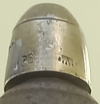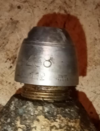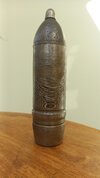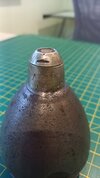I have attached a picture of a recently acquired 7.5cm pak 40 hollow charge projectile. It has a steel nose piece. I have seen and handled many HC projectiles over the years for different 7.5cm guns but never seen one that was all steel. Is there a specific designation for this and are there many others around? TIA.
British Ordnance Collectors Network
You are using an out of date browser. It may not display this or other websites correctly.
You should upgrade or use an alternative browser.
You should upgrade or use an alternative browser.
All steel 7.5cm Pak 40 hollow charge projectile
- Thread starter Burney Davis
- Start date
- Status
- Not open for further replies.
high-value-target
Member
To my knowledge there was never any specific designation for the steel hood or any other type of material as there was for the driving bands (e.g. FES). At least I have never come across it. Personally I have only seen perhaps 2 or 3 of the all steel ones and only recognised them as such due to corrosion. I guess Zinc was also getting rare towards the end of 1944 and the manufacturing process for the drawn steel hood was reasonably faster and resource-saving.
I think you are most likely right in these being late war production. I've always thought they could have used steel rather than zinc alloy as standard.To my knowledge there was never any specific designation for the steel hood or any other type of material as there was for the driving bands (e.g. FES). At least I have never come across it. Personally I have only seen perhaps 2 or 3 of the all steel ones and only recognised them as such due to corrosion. I guess Zinc was also getting rare towards the end of 1944 and the manufacturing process for the drawn steel hood was reasonably faster and resource-saving.
The fuze is not fully seated in the picture but it does screw down correctly. Only markings are the 2754 shown in the picture.Aren't there any stamps on it? Is the fuze screwed in completely on the picture?
The Czech nz40 fuze used with HEAT projectiles had 20x1 thread the AZ38 has 18x1 thread.
I do not recall seeing a Czech manufactured HEAT round in 75 mm. All post war manuals mention ex-German ammunition fitted with AZ38 fuze.
How about Hungarian, the 42M is quite a small fuze.
Bob.
I do not recall seeing a Czech manufactured HEAT round in 75 mm. All post war manuals mention ex-German ammunition fitted with AZ38 fuze.
How about Hungarian, the 42M is quite a small fuze.
Bob.
It makes no sense to number the front ogival when there is no identical number on the cylindrical part.
In my opinion, it is a composite of several pieces...
Even the fuses diameter is larger compared to the diameter of the mouthpiece than it should be.
If I remember the piece I had in my hand, it is quite different..
Akon
In my opinion, it is a composite of several pieces...
Even the fuses diameter is larger compared to the diameter of the mouthpiece than it should be.
If I remember the piece I had in my hand, it is quite different..
Akon
The fuze is a perfect fit for the top ogival piece (it simply isn't screwed down in the picture) and is an AZ38. I suspect that the round was originally rusty and removing the rust has perhaps reduced the surface by half a milimeter but not enough to remove markings if they were of the same type as the one that can be seen.It makes no sense to number the front ogival when there is no identical number on the cylindrical part.
In my opinion, it is a composite of several pieces...
Even the fuses diameter is larger compared to the diameter of the mouthpiece than it should be.
If I remember the piece I had in my hand, it is quite different..
Akon
I have handled well over a dozen good condition HC projectiles in recent years and can confidently say that not all were marked with matching numbers (top and body) and some numbers were mismatched but definitely together from birth evidenced by original paint.
Anyway, my original question has been answered so thanks to all.
Hi Burney DavisThe fuze is a perfect fit for the top ogival piece (it simply isn't screwed down in the picture) and is an AZ38. I suspect that the round was originally rusty and removing the rust has perhaps reduced the surface by half a milimeter but not enough to remove markings if they were of the same type as the one that can be seen.
I have handled well over a dozen good condition HC projectiles in recent years and can confidently say that not all were marked with matching numbers (top and body) and some numbers were mismatched but definitely together from birth evidenced by original paint.
Anyway, my original question has been answered so thanks to all.
Can you post a photo where the numbering is only on the ogival piece +cylindrical part ? Or a photo cylindrical part are numbered (same or different number), all assuming the paint is intact, i.e. those that have been demonstrably not taken apart.
Thanks Akon.
The large diameter of the fuse for the AZ 38 type is definitely 24mm. I'm basing it on the documentation ...
Your sample on the left / Another sample.As you can certainly see, your front ogival (photo on the left) has a different diameter at the point of contact than the fuse diameter ... which logically implies to me that it is not adapted to the fuse diameter, which is definitely 24mm.
On the contrary, in the photo on the right you can see that the front ogival has the same diameter as the fuse diameter, i.e. 24mm.
Unfortunately, what I see cannot be unseen.
Akon


Your sample on the left / Another sample.As you can certainly see, your front ogival (photo on the left) has a different diameter at the point of contact than the fuse diameter ... which logically implies to me that it is not adapted to the fuse diameter, which is definitely 24mm.
On the contrary, in the photo on the right you can see that the front ogival has the same diameter as the fuse diameter, i.e. 24mm.
Unfortunately, what I see cannot be unseen.
Akon


Here is an example, sadly in crap (Infantry term) condition, at least as far as the zinc alloy nose cone is concerned, and the fuze as well, come to that, but I agree with Alpini that the body should be full of stamps, and possibly white paint markings as well. In addition, mine has a thin layer of protective varnish or lacquer, greenish in colour, extending over the body and base of the round and clearly original. I also agree with Akon_ from Enterprise, wherever that might be, that the AZ 38 fuze is precisely 24mm in diameter as measured. Not sure what Barney's fuze might be, unless there are significant variations that retain the same designation, and it certainly looks right. I have never heard or seen such, but others will know more than me.
Alan1![DSCN1045[1].JPG DSCN1045[1].JPG](https://www.bocn.co.uk/data/attachments/181/181143-679c7884b1bb5d7ba9826a874bef6031.jpg)
Alan1
![DSCN1045[1].JPG DSCN1045[1].JPG](https://www.bocn.co.uk/data/attachments/181/181143-679c7884b1bb5d7ba9826a874bef6031.jpg)
Hi Alan 1
I have one more supporting argument that tells me that it is assembled from multiple parts from other shell .i.e. deep corrosion is more or less absent on the cylindrical part - you can see how the material was removed with a knife during turning and these lines are not disturbed by deep corrosion. Unlike the front ogival where the corrosion is deep and surface (not local) and when I compare the body and the ogival it does not fit.
Then there was the idea whether it is not different with the AZ 38 St fuse and unfortunately it is not, it also has a 24mm body diameter.
So this direction also falls.
Akon
I have one more supporting argument that tells me that it is assembled from multiple parts from other shell .i.e. deep corrosion is more or less absent on the cylindrical part - you can see how the material was removed with a knife during turning and these lines are not disturbed by deep corrosion. Unlike the front ogival where the corrosion is deep and surface (not local) and when I compare the body and the ogival it does not fit.
Then there was the idea whether it is not different with the AZ 38 St fuse and unfortunately it is not, it also has a 24mm body diameter.
So this direction also falls.
Akon
I thank Akon_ for his further explanation of thought processes.
Careful scrutiny of the picture bears out his view that this is a bitser, and I certainly believe that the body of the shell should be well marked with acceptance stamps and manufacturer's id codes etc. A quick check of a representative sample from my own collection attests to that.
I very much hope that Barney will continue with his enquiries and will come up with a positive id, or id's, as the case might be.
Alan1
Careful scrutiny of the picture bears out his view that this is a bitser, and I certainly believe that the body of the shell should be well marked with acceptance stamps and manufacturer's id codes etc. A quick check of a representative sample from my own collection attests to that.
I very much hope that Barney will continue with his enquiries and will come up with a positive id, or id's, as the case might be.
Alan1
The Czech Army did not order HEAT ammunition from manufacturers until 1951 because the ammunition was still in the development phase ....In addition to the design of ammunition in Czech conditions, they first had to solve the problem of mixed explosives TNT/Pentrit and TNT/Hexogen because until then Skoda had not worked with these mixtures in series. The company provisionally proposed the use of pure TNT, but this was understandably not accepted due to the small cumulative output ..... therefore, it was awaited for the completion of the production plant for these explosives and their subsequent mixing (Pentrite was mixed into the TNT melt) and the mastery of the laboratory (by casting).Could be a post ww2 czech made?
From 1948-1949, there was a demand (actual orders) from the army for this type of ammunition (by Škoda and by the design of the designs by the army). New designs were first developed for the 76mm caliber for Russian guns and for the 105mm German guns (i.e. simultaneously). The army also requested 75mm (German guns) and 122mm (Russian guns) and other calibers/State . It is necessary to state that after the war, Czechoslovakia produced new ammunition for trophy weapons: England, the USA, Germany, Russia, and each of these types has its own "pedigree" and specifications. All the army's requirements had priority and there was nothing that the industry would refuse to produce.... Before the serial version was introduced, there were quite a few intermediate types that the company produced and tested together with the army, including the prototypes of the nz 40 fuse.
Akon
All I can say is read my earlier comments and don't assume things when you don't have the item in question. The fuze was not screwed into the top piece in my original picture. This round has NOT been assembled from various parts. The picture below shows the fuze sitting correctly in the top piece and is exactly the same as the other five HC projectiles that I have.The large diameter of the fuse for the AZ 38 type is definitely 24mm. I'm basing it on the documentation ...
Your sample on the left / Another sample.As you can certainly see, your front ogival (photo on the left) has a different diameter at the point of contact than the fuse diameter ... which logically implies to me that it is not adapted to the fuse diameter, which is definitely 24mm.
On the contrary, in the photo on the right you can see that the front ogival has the same diameter as the fuse diameter, i.e. 24mm.
Unfortunately, what I see cannot be unseen.
Akon
View attachment 205134View attachment 205135
Attachments
Burney Davis, thank you for the photo. Here I can see that the fuse is resting on the front part 
That would have solved that little misunderstanding.
is the body painted with something inside - asphalt paint (like the war ones)?
If the shel is without any stamped markings (except the number) I would say that this is atypical for wartime production and what is the reason for that?
as I wrote, such products were produced in our country after 1951, even for export, but there are a lot of questions ...
And is it wartime production at all, is there also a question? The fact that there is a wartime fuse still does not prove anything ...
If I stick to that number as a marker, who else used it in Europe? Hungary I don't know, I don't know
Akon
That would have solved that little misunderstanding.
is the body painted with something inside - asphalt paint (like the war ones)?
If the shel is without any stamped markings (except the number) I would say that this is atypical for wartime production and what is the reason for that?
as I wrote, such products were produced in our country after 1951, even for export, but there are a lot of questions ...
And is it wartime production at all, is there also a question? The fact that there is a wartime fuse still does not prove anything ...
If I stick to that number as a marker, who else used it in Europe? Hungary I don't know, I don't know
Akon
- Status
- Not open for further replies.


